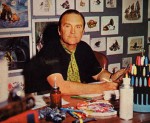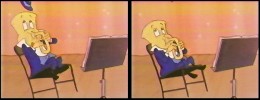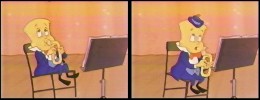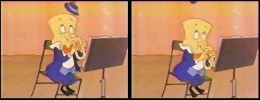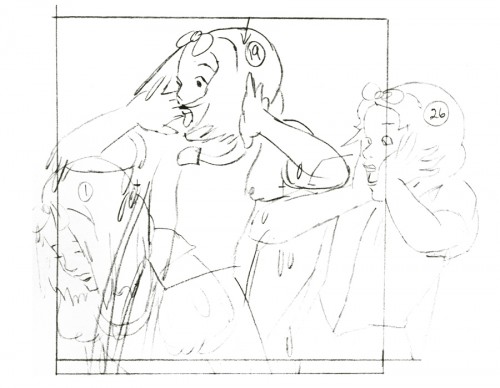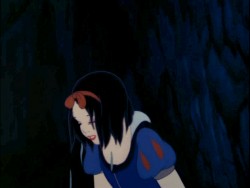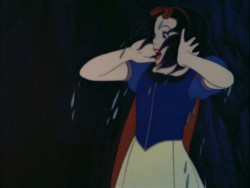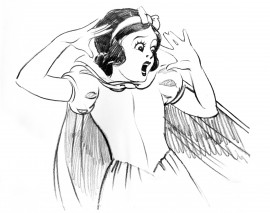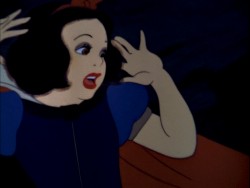Category ArchiveCommentary
Animation &Commentary 30 Apr 2007 08:02 am
Blum Commentary
- I read an editorial in an April 10th issue of The NYSun, and thought I’d put all of the attention of today’s blog into it. Normally, I wouldn’t put up an entire piece like this, but what the hell? I like it, and I don’t want it go completely unnoticed.
The commentary is by David Blum and is called
. . . . . . . . . . . . . . . . . . . . . “Who’s Laughing Now?”
- Is it genuinely funny to see an animated, overweight, middle-aged dude on a living room couch, waiting for the chorus of the “Maude” theme song to kick in? To me it’s mildly amusing, but I don’t think I’m supposed to be the target audience for Fox’s “The Family Guy,” where that reference turned up on a recent episode. Very few 12-year-olds have a working knowledge of theme songs from 1970s sitcoms, and those who do need to get into something more useful, like stamp collecting. But this is what happens when you entrust the writing of prime-time cartoons to adults. They write what they know. And if you’ve ever met a Hollywood television comedy writer, you know that most of them grew up with baby sitters named Sony and Panavision.
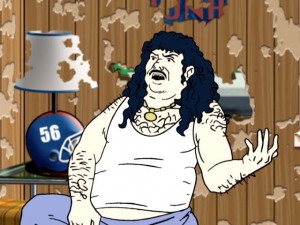 It’s not fair that so many jokes on television’s most popular cartoons don’t work for people who don’t shave. That’s the target audience, and who Hollywood hopes to attract by turning these cartoons into movies themselves — “The Simpsons” movie opens in July, and the Cartoon Network’s “Aqua Teen Hunger Force” full-length version arrives in theaters this Friday. Maybe a few smart kids will get these shows’ highbrow allusions to movies like “The Natural” and “2001: A Space Odyssey,” but most preteens don’t get these nods to the past, and their parents don’t do much more than note them and nod off.
It’s not fair that so many jokes on television’s most popular cartoons don’t work for people who don’t shave. That’s the target audience, and who Hollywood hopes to attract by turning these cartoons into movies themselves — “The Simpsons” movie opens in July, and the Cartoon Network’s “Aqua Teen Hunger Force” full-length version arrives in theaters this Friday. Maybe a few smart kids will get these shows’ highbrow allusions to movies like “The Natural” and “2001: A Space Odyssey,” but most preteens don’t get these nods to the past, and their parents don’t do much more than note them and nod off.
Okay, so I was home as a kid watching memorable movies and sitcoms, too, and I get the gags on “Family Guy” — most of them, anyway. But they’re more likely to make me wince at my vast, unnecessary knowledge of trivia than laugh at the repetition. A single episode contains so much material culled from television that it’s impossible to keep track of it all; one random episode included mentions of “dingo and the baby” (an homage to the 1988 Meryl Streep movie, “A Cry in the Dark), “Masturbator & Commander” (after the Russell Crowe movie “Master & Commander”), and an ice-cream-and-punishment sequence lifted directly from the 1980 Academy Award-winning movie, “Kramer vs. Kramer.”
There’s so much material in “Family Guy” taken from elsewhere that it inspired ridicule on an episode of “South Park,” in which the show’s writers were portrayed as manatees getting their joke notions from “idea balls” spinning freely in a giant bin.
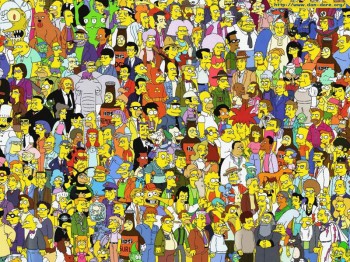 The writers at “The Simpsons” aim higher than “Family Guy,” but sometimes end up in the same place — with lines that resonate more with memory than humor. “As God is my witness,” Homer Simpson declares in one episode as he begins a new diet, “I’ll always be hungry again!” Is that funny, or is it just familiar? I don’t think there’s all that much entertainment value in a television version of Trivial Pursuit, and that’s what television cartoons have largely become — a catalog of lines from old movies, theme songs from 1960s sitcoms, and mentions of actors like David Hasselhoff. I’m probably the only person in my ZIP code to catch the “Simpsons” reference to Fox’s 1991 sitcom trainwreck “Herman’s Head,” and that’s not a proud moment.
The writers at “The Simpsons” aim higher than “Family Guy,” but sometimes end up in the same place — with lines that resonate more with memory than humor. “As God is my witness,” Homer Simpson declares in one episode as he begins a new diet, “I’ll always be hungry again!” Is that funny, or is it just familiar? I don’t think there’s all that much entertainment value in a television version of Trivial Pursuit, and that’s what television cartoons have largely become — a catalog of lines from old movies, theme songs from 1960s sitcoms, and mentions of actors like David Hasselhoff. I’m probably the only person in my ZIP code to catch the “Simpsons” reference to Fox’s 1991 sitcom trainwreck “Herman’s Head,” and that’s not a proud moment.
The cannibalizing of the actual classics will result in another, more pernicious effect in the years to come — taking away the pleasure for kids of seeing the original source material from which great lines and memorable scenes are taken. When the latest generation of preteen cartoon-watchers grows up and sees the horse’s head sequence from “The Godfather,” they’ll have the implanted memory of the “Simpsons” episode in which Bart found the head of the Jebediah Springfield statue in his bed. Won’t that reduce the shock value, later in life, of seeing John Marley wake up to the sight of his silk bedsheets drenched in blood? The entire “Treehouse of Horror V” episode functions as a parody of “The Shining,” a movie most “Simpsons” fans won’t see for years. All references and no jokes make “The Simpsons” a dull show.
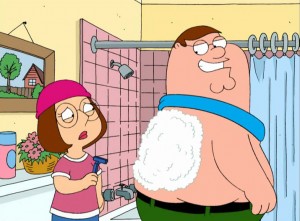 This isn’t meant as a broadside against “The Simpsons,” which even at its weakest spins its thievery with wit and remains one of television’s finest achievements. And “Family Guy,” for all its dependence on cultural references and quotations, manages to be funny much of the time. It’s just that when the references become as tired as they’ve grown lately — “Family Guy” has, most recently, been borrowing from the comedy stylings of Carol Burnett, who has reciprocated by suing — you start to wonder about the point. Even more troubling than the trend itself may be the prospects for the future of cartoons. What will be left for the animated-comedy writers of tomorrow to borrow? At least this generation had some good material to use. Given the current scarcity of classic movies, it’s not implausible to imagine cartoons of the future stealing from Stewie Griffin of “Family Guy” or channeling Homer Simpson for their scripts. Will our children’s children find that funny? I seriously doubt it.
This isn’t meant as a broadside against “The Simpsons,” which even at its weakest spins its thievery with wit and remains one of television’s finest achievements. And “Family Guy,” for all its dependence on cultural references and quotations, manages to be funny much of the time. It’s just that when the references become as tired as they’ve grown lately — “Family Guy” has, most recently, been borrowing from the comedy stylings of Carol Burnett, who has reciprocated by suing — you start to wonder about the point. Even more troubling than the trend itself may be the prospects for the future of cartoons. What will be left for the animated-comedy writers of tomorrow to borrow? At least this generation had some good material to use. Given the current scarcity of classic movies, it’s not implausible to imagine cartoons of the future stealing from Stewie Griffin of “Family Guy” or channeling Homer Simpson for their scripts. Will our children’s children find that funny? I seriously doubt it.
– Don’t miss Mark Kennedy‘s blog, Temple of the Seven Golden Camels. Today, it features Ken Anderson‘s African sketchbooks.
Anderson was a Disney artist/designer most of his life. He was one of the old-time animation guys who used real life for his inspiration, not other cartoons or television shows. He was something of a Renaissance man for Disney.
Animation &Commentary 05 Apr 2007 07:58 am
Tubby
- I was reading the 1957 Disney Studio Directory posted on Joe Campana‘s site, Animation – Who & Where. when I came upon the name of Howard Diettrich. This threw me back to 1973 and Tubby The Tuba.
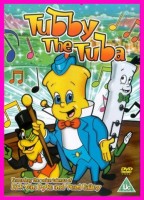 I’d just been layed off at the Hubley Studio, after completing the first 20 (of 60) episodes of Letterman. Officially, I had been categorized as an “inbetweener” in the Union. I’d done everything from animate to ink at Hubley’s, but that was my category. I received a call from Johnny Gentilella. We’d met through Hubley, and he was now working for NY Institute of Technology. They were in the early stages of production on their feature, Tubby The Tuba, and I was offered the job of Assistant Animator, a categorical promotion.
I’d just been layed off at the Hubley Studio, after completing the first 20 (of 60) episodes of Letterman. Officially, I had been categorized as an “inbetweener” in the Union. I’d done everything from animate to ink at Hubley’s, but that was my category. I received a call from Johnny Gentilella. We’d met through Hubley, and he was now working for NY Institute of Technology. They were in the early stages of production on their feature, Tubby The Tuba, and I was offered the job of Assistant Animator, a categorical promotion.
NYIT was the school I’d graduated from and received my BFA; it was located in Old Westbury, Long Island – about an hour’s drive from Manhattan. It’d be interesting, returning to my old school just to see how it had changed. By taking the Long Island Rail Road, I was able to cut down that ride by a few minutes and leave the driving to someone else. I was picked up at the station and driven to the animation building, a small cottage on the campus. Everyone was out to lunch except for Johnny Gent, and he drove me (about a couple hundred yards) to meet Sam Singer, the producer recently hired to do the film.
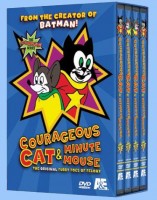 Singer had done all those Courageous Cat cartoons that had infested children’s programming back in the late 60s/early 70s. Oddly, I enjoyed them; I always was a glutton for bad animation. Love those cel flares, shadows, scratches and cel edges.
Singer had done all those Courageous Cat cartoons that had infested children’s programming back in the late 60s/early 70s. Oddly, I enjoyed them; I always was a glutton for bad animation. Love those cel flares, shadows, scratches and cel edges.
I was directed to his office. In there was another producer (I’ll hold back his name) who had broken his ankle and was on crutches. I got to meet the two of them and listen to them kibbitz around me, virtually ignoring me for a few minutes. Singer was chewing on a cigar, and I couldn’t take my eyes off the spittle that seemed to be moving down the cigar in his mouth. When I finally left to return to the animation building, I saw that Singer was also on crutches. He had a clubbed foot.
I sort of remembered that meeting as an omen of things to come. The entire place, while I was there, felt like it was on crutches.
I liked Johnny Gent a lot; we got along well at Hubley’s; on Letterman I got to mangle quite a few scenes by him as I learned how to inbetween properly.
There were only about 8 others at NYIT at the time. Other people I met included Walt Kubiak, another assistant who I enjoyed talking to; animator, Chuck Harriton, who I’d met at Hubley’s (and never really was crazy about); Lou Marcus who was filming the work on an Oxberry. Lou had gone back in animation for many years and had plenty of stories to tell. (See Andrew Marcus’ comment below.)
The person I most associated with was the editor of the film, Phillip Schopper. He was a young guy who took the LIRR everyday from Brooklyn to Old Westbury. We’d meet daily on the train and laugh over the events of the days out there. I’ve stayed friends with Phillip, who has become a first-rate filmmaker; we rarely talk about those days at NYIT.
It was not a fun place to work. At the time, everyone chatted over their cubicle walls. I was in the front of the studio with full view of the front door. I was constantly getting notes from Chuck Harriton who persistently altered the models of the characters in ways that no one else was drawing. I was forced to work his scenes off-model. Johnny Gent always had a beautiful drawing style and made it easy for assistants to follow and inbetween. He and I spent most of our lunch hours alone together in the studio. We were able to have quite a few conversations; I loved that part.
Everyone seemed to back talk everyone else as they walked out the front door. I couldn’t help wondering what they said about me when I left. Too much swiping makes for an unpleasant working condition.
At one point, Sam Singer brought in a number of his people from California. I’d already been there about four weeks so was glad to see some new blood. Many of the few people were ex-Disney people, so there was a lot for me to learn. Nino Carbe, was a good example of this. He had done some incredible work at Disney’s on Fantasia and other films. He was an artistic force and a nice guy to meet.
Howard Diettrich was a virtuoso assistant who had worked on Sleeping Beauty. Unfortunately, he was an alcoholic who had a big problem. Sam Singer took him under his wing and had decided to cure him. Hypnotherapy came in, and Howard went through the mill for Singer. It made a soap opera of a story for all of us working there, and it was hard for me to watch.
I decided to leave. They wouldn’t allow me to quit without going to Alexander Schure. He was the President of the school – yes, NYIT was still predominantly a school – and he was financing the whole thing. His idea, ultimately, was to introduce computer animation to the world, and he invested heavily there. Some of the brilliant people who grew out of this department moved on to develop Lucas and Pixar.
So I went to Alexander Schure, and he argued with me for about 30 minutes. I told him that the travel time was too much. He didn’t accept that. He liked the fact that I was an art school grad from his school and was working there. He offered to have his son pick me up and drive me.
I knew that there was no solid directorial voice coming from the top, and the film could never be good. My artless tactic was to say as much. He told me that he was going to take over from Sam Singer, and he would be the voice of clarity. Now I knew I really had to get out. He finally surrendered, and I left. Happily.
I was back with Hubley within two weeks. Even better.
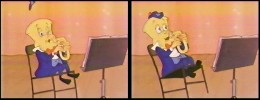 I didn’t get to see the film until I borrowed a vhs copy from Dante Barbetta, who eventually joined their staff to animate when it got significantly larger.
I didn’t get to see the film until I borrowed a vhs copy from Dante Barbetta, who eventually joined their staff to animate when it got significantly larger.
That was not a good film, as a matter of fact it was incredibly bad. I’m not sorry I left, though I would have enjoyed more time with Johnny Gent; it was the last time I worked with him. I also still wonder what happened to Howard Diettrich.
Note: Last year, John Celestri wrote about the later period in the making of this film on Mark Mayerson‘s site. Part I and Part 2.
Articles on Animation &Commentary 31 Mar 2007 08:23 am
New Guys and Old
Meet The Robinsons opened yesterday to largely negative reviews in NYC. The NYTimes critic, A.O.Scott, started his review with these two paragraphs:
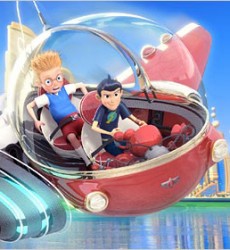 At the end of “Meet the Robinsons,†a new 3-D computer-animated Disney film (loosely based on a popular children’s book by William Joyce), the screen is filled with an inspiring quotation from Walt Disney himself. The gist of it is that “around here†— meaning at Disney’s entertainment workshop — not a lot of time is spent looking backward. Instead, the motto is, as it is for some of the characters in the film, “Keep moving forward.â€
At the end of “Meet the Robinsons,†a new 3-D computer-animated Disney film (loosely based on a popular children’s book by William Joyce), the screen is filled with an inspiring quotation from Walt Disney himself. The gist of it is that “around here†— meaning at Disney’s entertainment workshop — not a lot of time is spent looking backward. Instead, the motto is, as it is for some of the characters in the film, “Keep moving forward.â€
In other words, learn from your mistakes. And it seems appropriate that this great man’s words appear at the end of this movie, since they implicitly invite you to forget what you have just seen and may even serve as a sort of apology. Whether or not it counts as a mistake — movies tend to be made on purpose — “Meet the Robinsons†is surely one of the worst theatrically released animated features issued under the Disney label in quite some time.
Most of the reviewers I’ve read came to the same conclusion about that bit of text at the end of the film. I wonder if anyone out there knows the story as to why the decision was made to place this quote at the tail of the movie. If you do, I’d appreciate hearing it.
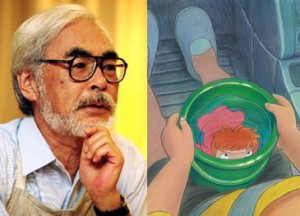 – Of course, there’s nothing like an old master to bring us back to the basics.
– Of course, there’s nothing like an old master to bring us back to the basics.
News was revealed this last week that Miyazaki is at work on his next feature film, Ponyo On a Cliff. This is the story of a five year old boy, Soskue, and the goldfish princess, Ponyo. The film is set for a Summer 2008 release in Japan. Miyazaki is doing the storyboard with watercolors and pastels. I wouldn’t mind if they released the animatic version of his films. His storyboards are the heart of the movies. A Variety article had this to report:
- Instead of incorporating ever more CG cuts into 2-D animation, as Studio Ghibli has done in recent pics, Miyazaki intends to make “Ponyo” with a pastel watercolor, hand-painted look.
Miyazaki will “go back to his origins and use not any CG,” Studio Ghibli prexy Toshio Suzuki told reporters at Monday’s press conference announcing the toon. “Instead he will use simple, childlike drawings. He intends to make something different from his previous films.”
Daniel Thomas MacInnes, naturally, posts one of the best pieces about this film on his site, Conversations on Ghibli.
Not far from the same subject, there’s an interesting post at AniPages Daily. It places the focus squarely on the female animators working at Ghibli. It’s nice to see some bios of these lesser known Japanese animators, and I thank Ben Ettinger for the post.
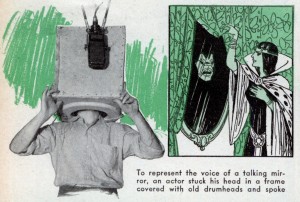 - Just in case you missed it, Cory Doctorow brought to the attention of Boing Boing an article in Popular Mechanix on the making of Snow White. It’s worth a look; some of the graphics are beautiful. the article is five pages long.
- Just in case you missed it, Cory Doctorow brought to the attention of Boing Boing an article in Popular Mechanix on the making of Snow White. It’s worth a look; some of the graphics are beautiful. the article is five pages long.
The illustrations for the article (e.g. the one on the left) seem to use early production art. There isn’t much resembling the final film, despite the magazine’s 1938 publication date.
- A couple of sites have appeared on my horizon that I’d like to point out to you:
Mike Matei has a site, Classic Animation, which features a lot of animated shorts of the YouTube style. However, many of them are hard to see Van Buren films. It’s good to see a lot of the B&W Tom and Jerry cartoons (the Mutt & Jeff impersonators not the cat and mouse). It’s a good way to spend some time if you have it.
I found this site through Tom Stathes‘ Cartoons on Film blog. This site pays a lot of attention to the silent and early sound cartoons. Many of them can be bought on dvd through there.
A post about the two Amos and Andy animated shorts brought Mike Matei to comment with posted versions of both shorts. I last saw these in silent 8mm versions I’d owned (I bought them for $.99 way back when), so it was interesting seeing them again.
Commentary 30 Mar 2007 08:03 am
tup tup
- Infrequently, there are cartoons which sometimes make a difference as to how you see a particular character, or studio, or sometimes even the world. One of these I recently thought of was Tup Tup by Nedeljko Dragic in 1972. It was nominated for the Oscar and lost to Richard Williams’ Christmas Carol.
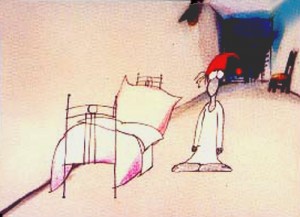 I had seen a lot of films from Zagreb and had heard a lot about how great they were. They were even Oscar winners for Ersatz in 1962. Yet, I wasn’t a fan. I didn’t understand the acclaim the films were getting, yet kept it to myself. It was obvious that I was the alone in my opinion, and it confused me.
I had seen a lot of films from Zagreb and had heard a lot about how great they were. They were even Oscar winners for Ersatz in 1962. Yet, I wasn’t a fan. I didn’t understand the acclaim the films were getting, yet kept it to myself. It was obvious that I was the alone in my opinion, and it confused me.
So along comes Dragic‘s film, Tup Tup. At first the film was annoying, but then it got under my skin and stayed with me. The cartoon had an insidious insanity which overwhelmed and haunted me.
I started looking at Zagreb shorts a little differently, but, I’m sad to say, my opinion didn’t change much. Many of the films just seemed like a new-found freedom in an iron curtain country, but it didn’t make the films great to me. I was a very big fan of UPA and Hubley at the time, and Zagreb didn’t come close.
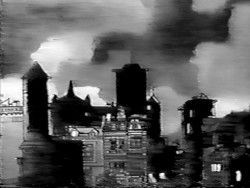
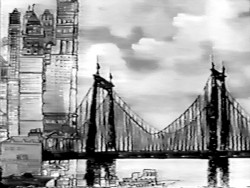
(Some frame grabs from The Four Poster. Go here to see some great stills of artwork.)
I’d even heard about the effect The Four Poster had had on the Zagreb founders. Apparently, when this live action/animation feature made it to Yugoslavia, they hijacked the print and studied it for two weeks prior to returning it. Their admiration for Hubley‘s work in the Stanley Kramer produced feature film caused them to develop their own studio and style. A new animation studio was born. By the time I’d seen Tup Tup, I’d already seen The Four Poster on television (in the early sixties) and knew everyting about Hubley. Nothing I’d seen from Zagreb even compared to what I’d seen from UPA, never mind Hubley. It was all so cold and unemotional, to me, although it did try for some blaring stylization.
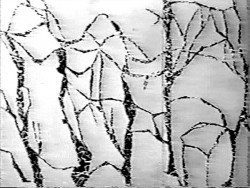
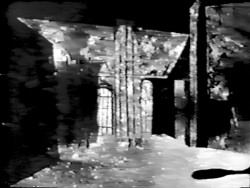
(More frame grabs from a bad dvd copy of The Four Poster.)
But there was Tup Tup. it stayed with me. The style of the film didn’t overwhelm the story, and I was into it.
To be honest, there were other films by Mr. Dragic that I found just as compelling. Diary is another excellent film which is literally an animated diary of his animation festival going. It’s not as persistent as Tup Tup, but it’s as gripping. I think ultimately, it’s a matter of the artist rather than the studio, and I suppose the same is true of any grouping of artists. The National Film Board has produced an inordinate number of brilliant films, but there are a few clunkers in there. The same is, I guess, true of Zagreb; I’ve only seen a couple dozen of their films, so I wouldn’t make a blanket statement.
Actually, the low budget films they produced, in retrospect, however small, are significantly better than 99% of what’s produced today. The difference is an intelligence behind the films. That’s conspicuously missing from most of the shorts we see today. Americans are generally trying to make stupidly funny shorts and aren’t concerned with articulating any statement about life or society. It’s sad, really. I wonder that I can make such negative comments about a studio like Zagreb when we’re living through such a fallow period.
There are a couple of dvds available of Zagreb films, but far too few. I don’t think Tup Tup is among those on dvd; at least I haven’t found it.
Tup Tup
1972 10min.,
Script, Director, Drawings, Animation, Backgrounds: Nedeljko Dragic
Music: Tomica Simovic
Commentary &Daily post &Mary Blair 27 Mar 2007 07:54 am
Song of the South links, etc.
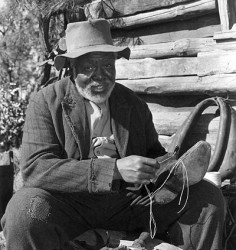 – USA Today has an article about Song of the South and the difficulties they seem to be having in releasing a dvd of the film. Isn’t it a little pathetic that the Disney execs have to squirm this much over the release of this film? Yes, we appreciate the political-correctness scares them, but is this film any worse than Gone With the Wind?
– USA Today has an article about Song of the South and the difficulties they seem to be having in releasing a dvd of the film. Isn’t it a little pathetic that the Disney execs have to squirm this much over the release of this film? Yes, we appreciate the political-correctness scares them, but is this film any worse than Gone With the Wind?
Isn’t it time the Disney folk gave James Baskett his due? He was the first African-American male to be given an Oscar (albeit a special award; he wasn’t put in competition). Baskett and Ethel Waters (who won Best Supporting Actress for Pinky that year) didn’t sit among the other stars, but were placed to the rear during the ceremony. Isn’t that the same thing Disney is doing, now using their fear of political correctness?
To this day his is still probably the best performance by an actor working with animated characters. There were significantly more restrictions on the actors then than there were at the time of Roger Rabbit, or anything more current (and controlled by computer aids.) It was all in his acting. The focus in his eyes tells you this man sees those characters, and they became real for us. Check out the Zip-A-Dee-Doo-Dah segment and look at his eyes. It’s outstanding.
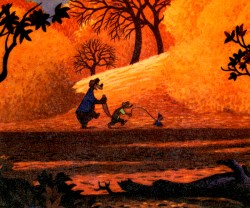 Read the Drafts for the film’s animation on Michael Barrier‘s site.
Read the Drafts for the film’s animation on Michael Barrier‘s site.
See some Mary Blair paintings done for this film on Amid Amidi‘s Cartoon Modern.
There’s a highly stylized Nash auto ad from the ’50′s on YouTube (in case you haven’t seen it) starring the three main characters from Song of the South.
Watch the Zip-A-Dee-Doo-Dah segment courtesy of Thad Komorowski.
The Asifa-Hollywood Animation Archive has some nice illustrations by Al Dempster and Bill Justice for a Little Golden Book version of the film.
 – Tom Sito had a nice little note on his blog today:
– Tom Sito had a nice little note on his blog today:
1952-U.P.A.’s cartoon Rooty-Toot-Toot premiered. Its music score was by jazzman Phil Moore, the first African American to receive a screen credit for scoring a movie.
Congratulations to SVA school grad, Dony Permedi for having won YouTube’s first ever award for the “Most Adorable” piece on the internet. His Kiwi was a Master’s thesis at SVA and has received over 6.5 million hits on the site. If you haven’t seen the Maya created video, check it out.
Stop Mo Expo – On Sunday, April 21st ASIFA Hollywood is presenting a day of celebration of 3D puppet animation. There will be all day seminars and conferences (from 9am to 5pm), as well as a number of screenings (from 6pm to 10pm). Filmmakers represented include: Will Vinton, the Chiodo brothers, Mark Caballero, Corky Quackenbush, and Seamus Walsh among others.
It will take place at Woodbury University, 7500 Glenoaks Blvd. Burbank, CA.
Vintage ToonCast is an entertaining site that includes a lot of public domain animated shorts such as Mel-O-Toons, Fleischer Superman,k Betty Boop and Popeye shorts, Daffy and the Dinosaur, A is for Atom (the John Sutherland film not the Disney “Our Friend the Atom”) and a lot more.
Commentary 22 Mar 2007 08:40 am
Nuts
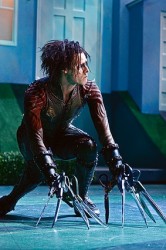 – Last night I got to see Edward Scissorhands, the Mathew Bourne ballet at the Brooklyn Academy of Music. (Watch BAM’s video montage here.)
– Last night I got to see Edward Scissorhands, the Mathew Bourne ballet at the Brooklyn Academy of Music. (Watch BAM’s video montage here.)
I like Bourne’s choreography; it seems to fit somewhere between Jerome Robbins and Mark Morris.
Caroline Thompson, who wrote the script for the original film, reworked the story for the ballet. (She also wrote Corpse Bride and Nightmare Before Christmas.)
Danny Elfman, who did the score for the movie added to the score for the ballet.
So, the set was beautiful, gorgeous costumes, original writer and composer, and I liked the choreography. What was wrong? Why didn’t I find it thrilling?
Five words: Johnny Depp, silence & Tim Burton.
(Click any image to enlarge.)
If you’re out to rework a movie that a lot of people love – and a lot of people love this movie – you’d better top it. That means you have to find an approach that is different than and better than Johnny Depp‘s character. Depp IS Edward Scissorhands! In the Bourne production, we had an imitation of the personality Depp created for that film. It was an original, and it can’t be duplicated by someone else, or it ends up feeling like one of those stuffed people dressed like Mickey Mouse and Goofy wandering around Disneyland. (A small side note: I once asked my young niece and nephew, who watched tv with me as Michael Eisner cavorted with people dressed like Donald and Mickey, if that was the REAL Donald and Mickey. They categorically said, “No!” The real characters were cartoons.)
Johnny Depp was being impersonated in this ballet, and the real guy was a pirate in a sequel coming out this summer.
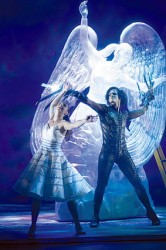 In the movie, Depp’s character was silent; everyone else talked. In the ballet, no one talked. This takes away from Edward’s character. He obviously CAN talk, now, since no one talks in this version – they performed mime to tell the story. Everyone was Edward Scissorhands.
In the movie, Depp’s character was silent; everyone else talked. In the ballet, no one talked. This takes away from Edward’s character. He obviously CAN talk, now, since no one talks in this version – they performed mime to tell the story. Everyone was Edward Scissorhands.
Tim Burton is an original. Go from Edward Scissorhands to The Corpse Bride to Willy Wonka to The Nightmare Before Christmas to Big Fish. No one has to tell you that Tim Burton made those films (with and without Caroline Thompson.) The ballet tried to recreate the movie; they tried to recreate Tim Burton. I’m sorry but originality can’t be duplicated.
I’m glad I saw the ballet, but I’d have preferred something original.
You can see more video clips on YouTube: go here.
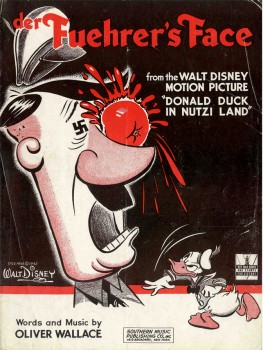 – Last year I posted the sheet music cover and talked about the animated short, Donald In Nutzi Land or, Der Fuehrer’s Face (after the name change).
– Last year I posted the sheet music cover and talked about the animated short, Donald In Nutzi Land or, Der Fuehrer’s Face (after the name change).
Now on the site Toons At War layout drawings for this sheet music have been posted. You’ll find a lot of other documents about the film there as well.
Bob Thomas, in the original The Art of Animation (1958) wrote the following story from composer, Oliver Wallace:
-
A favorite story of his concerns the time when Walt returned from Washington in wartime.
“I need a song for a cartoon the government wants me to do about the enemy,” Walt said. “It’s got to be serious, but funny.”
“You mean serious to them but funny to us?” Wallace suggested. (Click any image to enlarge.)
“Yes,” Walt replied.
The composer went home that evening, had dinner and took a nap. His wife asked him
to bicycle to the market with her. As he pedaled, a marching tune began to come to him.
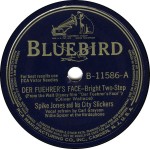 His wife lost him in the market and finally discovered him leaning against a wall and tapping his foot. When he got home, he went to work. In an hour and a half, the words and music to “Der Fuehrer’s Face” were ready for the publisher. Both the song and the Donald Duck short were hits. “Der Fuehrer” was hailed by Oscar Hammerstein II as the great psychological song of the war.
His wife lost him in the market and finally discovered him leaning against a wall and tapping his foot. When he got home, he went to work. In an hour and a half, the words and music to “Der Fuehrer’s Face” were ready for the publisher. Both the song and the Donald Duck short were hits. “Der Fuehrer” was hailed by Oscar Hammerstein II as the great psychological song of the war.
To hear the song as played by Spike Jones & His City Slickers go here.
The film is available on the Disney Treasures dvd On The Front Lines – Disney Goes To War.
Michael Barrier is hooked, and we benefit. He not only released the Draft for the Disney masterpiece, Who Killed Cock Robin?, but he’s produced a “Mosaic” Ã la Mark Mayerson. This, along with his Capsule notes on the film, give the short quite an analysis. Show and tell isn’t always enough. Good commentary is necessary. That’s where Mike Barrier and Mark Mayerson’s sites excel far beyond most. (Originality. I’ve heard that word before, somewhere.)
Animation Artifacts &Commentary 20 Mar 2007 07:33 am
Kimball
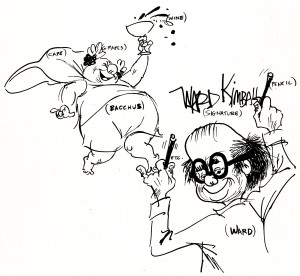 – I notice that there were a number of sites today featuring articles and material about Ward Kimball, (e.g. here and here) and there’s the Ward Kimball/My Space page which I visited. Jaime Weinman has a post that presents thoughts which I certainly agree with. In fact, they could have been mine.
– I notice that there were a number of sites today featuring articles and material about Ward Kimball, (e.g. here and here) and there’s the Ward Kimball/My Space page which I visited. Jaime Weinman has a post that presents thoughts which I certainly agree with. In fact, they could have been mine.
A year ago, I posted a couple of Kimball drawings. These came to me years ago (the 70′s?) via John Canemaker. The Bacchus drawing appeared in his Nine Old Men book. I have a few more drawings by Ward Kimball, and I thought it’d be nice to post a few of them.
I’ve always had mixed feelings about Kimball’s work. On the one hand his persona as presented to the public was always annoying. He came off as the wacky cartoonist who just wanted to show you how wacky he was. (There was a hint of this in Chuck Jones, as well.) He obviously had a big ego and had good reason for it. There was no doubt that this guy could draw like a son-of-a-gun, and his animation was often breathtaking. It always sided more toward the cartoon rather than the real, and it had a style so different from the others. You had to admire it.
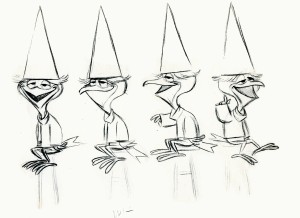 The crow sequence in Dumbo is brilliant, to say the least; the Mad Hatter in Alice is the heart of that film (though I wish it weren’t), and the Cheshire cat the most memorable part; and Toot Whistle Plunk & Boom is probably the best short done at Disney’s after WWII. However, there’s nothing I liked about the Oscar winning It’s Tough To Be Bird or Dad Can I Borrow The Car?. (This is a good example of Kimball’s personality entering the films.)
The crow sequence in Dumbo is brilliant, to say the least; the Mad Hatter in Alice is the heart of that film (though I wish it weren’t), and the Cheshire cat the most memorable part; and Toot Whistle Plunk & Boom is probably the best short done at Disney’s after WWII. However, there’s nothing I liked about the Oscar winning It’s Tough To Be Bird or Dad Can I Borrow The Car?. (This is a good example of Kimball’s personality entering the films.)
(Click any image to enlarge.)
.
The interview Mike Barrier did with Kimball in 1969-1986 offers some good insight into the man and some excellent detail. It adds to the piece Canemaker wrote in The Nine Old Men. Many people have written about Kimball, but I think John Canemaker‘s book has to cover his career best. It brings him to life and gives us a good encapsulation of his life and work.
.
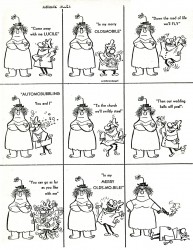
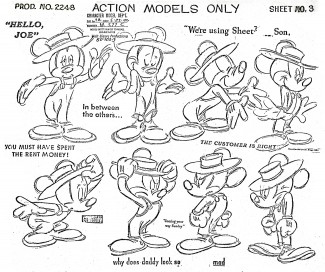
The comic to the left is obviously and ad parody, but don’t ask me what this Mickey compilation model sheet is. What’s with all the type?
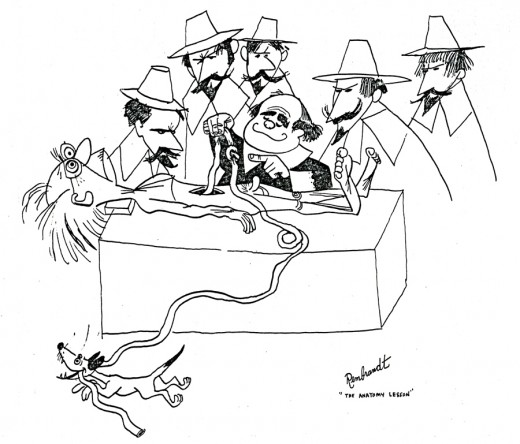
This was obviously a card for someone (Oliver Wallace?) who was operated on. I’m sure I’d have enjoyed something this funny if I was trying to recuperate.
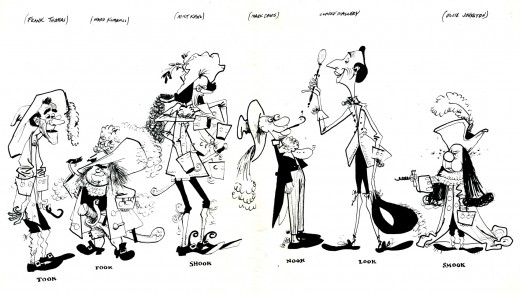
This caricature tells you that there must have been some real competition among the animators as the Captain Hook character approached.
You can watch some Kimball clips on YouTube (until someone takes them down.)
Disney Family Album Opening and Part 1 and Part 2.
Escalation, an independent anti-war (Viet Nam) short
the Snow White soup eating scene P.T.
Thad Komorowski has posted quite a few clips from Kimball. Here are some:
Cinderella‘s Lucifer
Dumbo‘s crows
Mother Goose Goes Hollywood 1, 2, 3
The Three Caballeros
Commentary &Daily post 09 Mar 2007 09:19 am
Peter Pan?
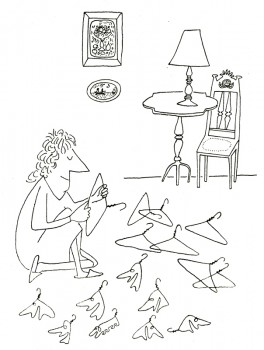
- Before I get into anything else, something has been buzzzing on the top of my head these past few weeks. Disney has released another dvd version of Peter Pan. This one comes with even more extras and special games for kids to play and dvd coloring books etc.
First there was the Limited Issue Peter Pan; then there was the Special Edition Peter Pan, and now there’s the two-disc Platinum Edition version. And they’re all still available.
What’s up? Where’s Pinocchio? Where’s 101 Dalmatians? Forget about Song of the South. (If any movie wanted a rerelease with extras, that’s it!)
Peter Pan is good, but it’s no Pinocchio.
Did I say Pinocchio?
- Mark Mayerson, on his site, has an excellent column about the opening of Pinocchio. This is his commentary after producing the excellent Mosaic of the first few sequences in the film. The internet seems to have been designed specifically for posts such as Mark writes. There’s little likelihood a book would have been published detailing a film as elaborately as has been done here. It’s done specifically for animation enthusiasts, and there wouldn’t be a market. Mark’s comments are the gold here; this is real analysis on the go. It’s hard to believe the amount of work Mark has undertaken in choosing to break down this entire feature. I’m immensely grateful. On top of that his analysis points to what we should have noticed for ourselves – from that Mosaic and from Hans Perk ‘s publishing the drafts to this film.
- Cartoon Brew, as I’m sure you’ve all noticed, has undergone some severe changes. This is obviously all to the better. They’ve had quite a few more posts (which will probably reduce in number as time moves on), but there have also been more links to art from the libraries of Jerry Beck & Amid Amidi. There’s gold in them thar hills.

![]()
Cartoon Brew Films is now up and running, and there’s no doubt that this will develop into an important site. Already they have some substantial films to view; the potential is enormous. It’s fun watching an enormous megalith of a site develop before our eyes.
- Speaking of Peter Pan, there’s a good article detailing the history of the next bad movie off-shoot, the Tinkerbell epic. You can get all the history of this extravaganza detailed on Chuck Oberleitner‘s site, O-Meon. Information you don’t really need about a movie you don’t need to see (unless you have a 14 year old girl in the house.)
- There are some nice MGM drawings posted at the ASIFA Hollywood Animation Archive. I’m a sucker for Srewy Squirrel. I like seeing any art from those films.
- My last Peter Pan reference will be to the amazing story meeting notes you can read on Devyn Marseilles‘ site: The Sacred Tree of the Aracuan Bird. Pt 1 & Pt 2. She has also given an amazing storyboard to Didier Ghez available on his site: Disney History.
By the way, the drawing at the top comes from
Saul Steinberg’s book All In Line (1945).
I just put it there because I like it.
Animation &Commentary &UPA 25 Feb 2007 09:54 am
There’s So Much Out There
- Mike Barrier had something interesting to say on his site, and this was compounded by Hans Perk‘s response on his site. I’ve thought about it all yesterday into this morning.
Mike pointed out the Hans was posting the Drafts for Pinocchio on his site, A Film LA. Of course, Barrier was pleased about this but wondered how much it was appreciated. He said that he found the response to some Song of the South drafts he’d posted last September
(pg 1, pg 2, pg 3, pg 4, pg 5, pg 6, pg 7, pg 8, pg 9, pg 10) brought little response to it.
The amount of work that goes into scanning and posting these things is enormous, I can assure you, and it’s disappointing when there doesn’t seem to be much of reaction in the community.
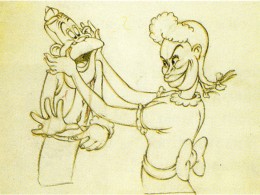 I immediately jumped to Hans’ site to see his response. Hans has been posting many of the Disney Drafts. Everything from Mother Goose Goes Hollywood to The Band Concert to . . . well, Pinocchio.
I immediately jumped to Hans’ site to see his response. Hans has been posting many of the Disney Drafts. Everything from Mother Goose Goes Hollywood to The Band Concert to . . . well, Pinocchio.
Hans pointed out that not only was he disappointed at some of the reaction of these drafts but even more so when he places some of the notes for the Action Analysis classes from the 30′s Disney studio. The silence gets to be deafening. He questioned whether there’s a lack of interest in how to best improve the quality of animation – even in the 3D business – without the knowledge of those who came before us.
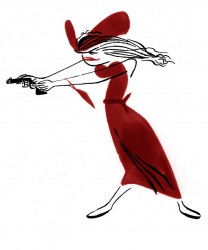 I had an amazing advantage coming along at the time I did and receiving some of the breaks I had. Of course, I wasn’t just searching for a job. This was always going to be my life. Getting a job working for and with my hero, John Hubley, at that developmental stage of my career, allowed me to ask questions and get a significant response. I knew not to bother him about history. (Disney and UPA were sore spots for John, and I stayed clear of the subject. The one time I mentioned it was after seeing Rooty Toot Toot for the first time, and, having been blown away by the film, mentioned it the next morning telling John what an amazing work it was. His response was to say, “Do you think so?” and leave the room. He wanted no conversation about it.)
I had an amazing advantage coming along at the time I did and receiving some of the breaks I had. Of course, I wasn’t just searching for a job. This was always going to be my life. Getting a job working for and with my hero, John Hubley, at that developmental stage of my career, allowed me to ask questions and get a significant response. I knew not to bother him about history. (Disney and UPA were sore spots for John, and I stayed clear of the subject. The one time I mentioned it was after seeing Rooty Toot Toot for the first time, and, having been blown away by the film, mentioned it the next morning telling John what an amazing work it was. His response was to say, “Do you think so?” and leave the room. He wanted no conversation about it.)
(Thanks to Cartoon Modern for this model.)
.
So, I would gather several questions and rework them so that in asking one good question, it would solve several for me. John always gave good answers to every question about the work, and I learned a hell of a lot.
But most people didn’t have access to John Hubley (or, in my career, Tissa David, Dick Williams, Art Babbitt or a dozen other brilliant people.) But there are these lecture notes from the Disney studio. And there are the Drafts where we can study the films, analyze who did what, and really get to know the significant difference between animators.
Mark Mayerson uses Hans’ Drafts to create these brilliant Mosaics on his site. He makes the work easier for us; we don’t even have to look at the film – it’s all layed out for us.
And then these scenes show up on YouTube somewhere else. You don’t even have to buy the films to see many of them. The Drafts Mike Barrier posted for Song of the South immediately turned up on Thad Komorowski‘s Animation ID site. (Disney, of course, removed it for copyright infringement, but it was there as was the opportunity to see it for a short bit.)
Basically, what all this rambling comes down to is that there’s so much out there. There’s so much to learn, and there’s so much opportunity to learn it. I love Tissa David, who I like to call my mentor. She is one of the great animators, trust me, and in her mid eighties she’s still animating. She says that she still has a lot to learn. If she feels that, imagine how I feel. Imagine how we all should feel.
Yet, there’s this incredible new tool out there – the internet. It gives us so much material and with sites like Mike’s and Hans’ and Mark’s and others (like most of those listed to the right of this post) we just have no excuse for all the bad animation out there. Get to work people; we’re all watching.
Hans points out in his commentary, that not publishing pictures probably gets less attention. Hence there are some pictures here.
The Oscars are tonight. I don’t like most of the animation choices.
For animated feature I see only one nominee that’s been animated, Cars. And I wasn’t crazy about that film. The animation was excellent in places, but conceptually the film’s a wreck.
For animated short, I didn’t think most of the films were good, never mind great. I voted for The Danish Poet since it was the only one that really told an adult story. It was a cheap gag or a sophmoric attempt at filmmaking. (Really, students have told many of these same stories without spending the wads of cash on them.) You all know my favorite was Joanna Quinn‘s film. That got my Oscar.
Commentary &Daily post 29 Jan 2007 07:46 am
BAFTA’s & Rotocapture
The nominees for the BAFTA Awards were announced last week. This is the British equivalent of the Academy Awards. Generally, a great winner emerges in the animated categories, particularly the shorts. This year is no exception:
Two of the nominees for Best Animated Feature match the Oscars: Cars, Happy Feet.. Flushed Away replaces Monster House on their list – appropriately, since it’s animated.
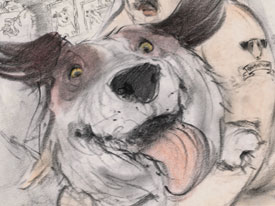 Nominees for Best Animated Short film are:
Nominees for Best Animated Short film are:
DREAMS AND DESIRES – FAMILY TIES – Les Mills/Joanna Quinn
GUY 101 – Ian Gouldstone
PETER AND THE WOLF – Hugh Welchman/Alan Dewhurst/Suzie Templeton
Peter and the Wolf by Suzie Templeton is a one hour animated film to the Prokofiev score. Click here to see a trailer.
Guy 101 by Ian Gouldstone is a short film about a man who hears a story about a hitchhiker from the other side of the Internet. The film was done as a student film for the Royal College of Art Animation. See it here.
Dreams and Desires: Family Ties by Joanna Quinn is a film about a woman and her home movies of a wedding. Brilliantly conceived and ridiculously skipped over by the US Oscar voters. It’s certainly the best animated short of the last year. The film is part of Don Hertzfelt & Mike Judge’s Animation Show which played in NY laste week.
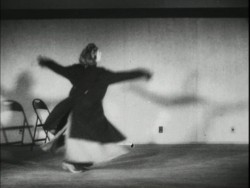 – A lot has been discussed in the past week about the validity of Motion Capture as a form of “Animation.” This conversation was instigated by the Oscar nominations. Two of the three nominations for the Best Animated Feature were created using MoCap.
– A lot has been discussed in the past week about the validity of Motion Capture as a form of “Animation.” This conversation was instigated by the Oscar nominations. Two of the three nominations for the Best Animated Feature were created using MoCap.
Mark Mayerson questioned if we shouldn’t be deciding whether we’re officially going to call Motion Capture animation. And if we shouldn’t, then is Cars the only officially nominated animated feature?
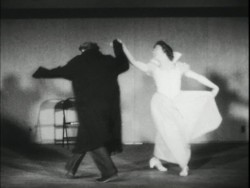 Now, of course, Motion Capture animators feel slighted. But they would have to agree that the soul, the impetus behind the movement does not come from them, but rather from the live action actor that was originally “captured”?
Now, of course, Motion Capture animators feel slighted. But they would have to agree that the soul, the impetus behind the movement does not come from them, but rather from the live action actor that was originally “captured”?
The comparison has been made that
traditional animation has often used Roto- scoping in creating animation. In fact, Disney’s Cinderella became the first feature that was wholly filmed in live action prior to 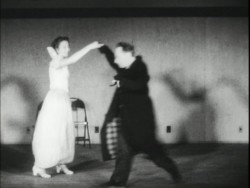
animation.
However, I’d like to make the point that the two methods are unrelated except in that live actors are involved. The difference to me, is that one is inspiration and the other is the heart of the animation.
When an animator is given live action reference material – the rotoscoped/traced drawings from the live action acting – he/she refers to it but animates to what is necessary for the scene. the animator is the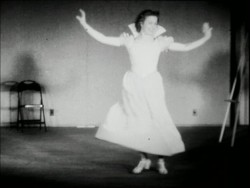 actor using the prerecorded voice, the physical rotoscoped reference, and anything available to help give the character a “soul.”
actor using the prerecorded voice, the physical rotoscoped reference, and anything available to help give the character a “soul.”
Even in Bakshi’s use of Rotoscoping in Lord of the Rings, the animators were allowed to push the drawings beyond the live action, alter the drawings to get them on character, and essentially produce the action.
When an “animator” gets the MoCap filmed live action, the actions are set. The actors have done the movement. What remains is 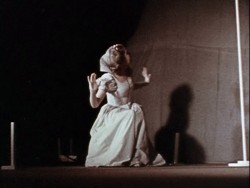 the proper positioning of the characters within the created scene, cleaning up the characters and constructing the scene. There’s no real animation, as we’ve come to know it.
the proper positioning of the characters within the created scene, cleaning up the characters and constructing the scene. There’s no real animation, as we’ve come to know it.
For years now, I’ve called this electronic puppetry, but that’s not really accurate. The site Digital Puppetry seems to have labelled it correctly.
Younger animators seem to have less a problem with all of this labelling and irritation accrued by older veterans. In fact, the 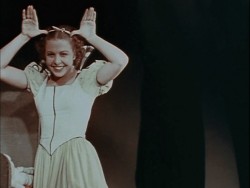 problem really is a threat to the “animator.” Last week, I hyperbolically suggested that the days of the animator were a dead as the dodo. You see, animation has turned into a computer effect. Live Action directors are now directing “animated films” in greater numbers. Peter Jackson had his “Gollum,” Robert Zemeckis had his “Polar Express” (and produced “Monster House”), Ang Lee had (and in fact acted) The Hulk. The “animators” have become interchangeable and almost irrelevant.
problem really is a threat to the “animator.” Last week, I hyperbolically suggested that the days of the animator were a dead as the dodo. You see, animation has turned into a computer effect. Live Action directors are now directing “animated films” in greater numbers. Peter Jackson had his “Gollum,” Robert Zemeckis had his “Polar Express” (and produced “Monster House”), Ang Lee had (and in fact acted) The Hulk. The “animators” have become interchangeable and almost irrelevant.
You aren’t able to define anyone’s animation style behind any of Tom Hanks’ characters in Polar Express. You can only see Tom Hanks or Savion Glover in Happy Feet.
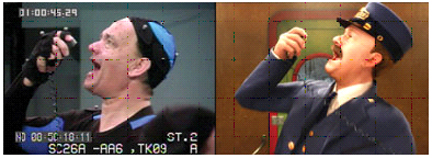
(All images except this one enlarge by clicking them.)
In Snow White, you can tell which scenes Grim Natwick animated; his style of animation comes across. It doesn’t matter how many rotoscoped drawings were given to him as reference. Grim animated the scenes.
In the big picture what really does all this quibbling matter? I enjoyed Happy Feet more than I did Cars. Cars was a better constructed film, both were riddled with cliches. I was entertained by all that dance. I like Savion Glover (though I would have preferred watching Savion Glover.) The film also seemed to have some sort of misguided representation of a message. I appreciated that. Cars, to me, had only a lot of loud noisy reverberation. From the first frame, the film came screaming. The artistry behind the imagery was astounding, as expected from Lasseter, but the film was boring.
Of course, this is only my opinion based on my biases. You have your opinions based on your biases. However, as an Academy voter, I’ll probably vote for Cars because I think technically it was a better “Animated” film. Isn’t that the category?
If you haven’t read Mark Mayerson or Keith Lango on this subject, you should.
Ward Jenkins reminded me that he had two interesting posts about Polar Express on his site. It gives an interesting look at how to correct the “Zombie Eyes” on the characters. #1 and #2. Check them out, if you haven’t seen them.
